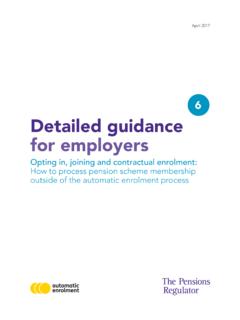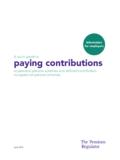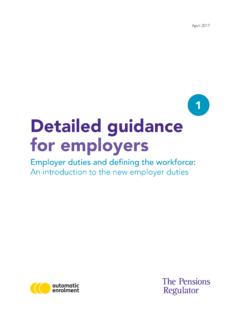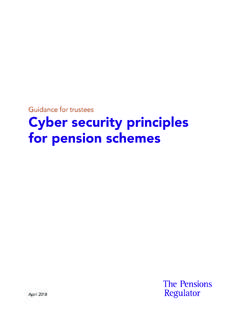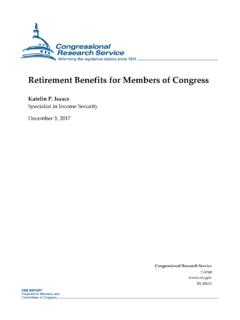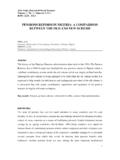Transcription of Regulatory code of practice No 8 - The Pensions Regulator
1 Regulatory code of practice no. 8. Member-nominated trustees and directors - putting in place and implementing arrangements Guidance for trustees Contents Paragraph Page Introduction 4. 5 The status of codes of practice 4. 6 Purpose of this code 4. 9 To whom does this code apply? 5. 11 Terms used in this code 5. 13 Changes to the legislation and the code 6. The legislation and code at a glance 7. Application of the requirements 8. 16 Determining whether the requirements apply 8. 19 Determining which requirements apply 8. 22 Determining when the requirements apply 9. 23 Determining how many MNT's are required 9. Compliance with the requirements 10. 29 Principles-based approach 10. 34 Putting arrangements in place 10. 35 Delegation and arrangements that are off 11. the shelf'. 38 What is a reasonable period for putting in place 11.
2 Arrangements? 41 Implementing arrangements 11. What is a reasonable period for the 12. 43 nomination and selection process to take place? 45 Recording compliance 12. Arrangements 13. 47 What are arrangements? 13. 48 General considerations 14. The nomination process 15. 50 Who can be nominated as an MNT? 15. 54 Whom to involve in the nomination process 15. 2. 56 Schemes with no active or pensioner 16 members 57 Involving organisations 16 58 Using only representative organisations 16 60 Examples of representative organisations 16 61 Using constituencies' 17 After nominations 18 62 Fewer nominations than vacancies 18 64 Re-running the nomination and selection process 18 The selection process 19 69 Who can be selected as an MNT? 19 70 Selection of a non-member 19 71 Who to involve in the selection process 19 74 Methods of selection 19 76 Examples of selection methods 20 Communication 21 What should be communicated?
3 21 77 Nomination 21 78 Selection 21 79 Outcomes 21 80 How should trustees communicate? 22 Reviewing the arrangements 23 Corporate trustees 24 86 A scheme has more than one corporate trustee 24 87 A company is trustee of more than one scheme 24 Appendix A: Corresponding Northern Ireland 25 legislation 3. Introduction 1. This code of practice is issued by the Pensions Regulator (the Regulator ), the body that regulates work-based pension arrangements (occupational pension schemes and certain aspects of stakeholder and other personal Pensions ). 2. The Regulator 's statutory objectives are to protect the benefits of pension scheme members, to reduce the risk of situations arising which may lead to calls on the pension Protection Fund, and to promote the good administration of work-based pension 3. The Regulator has a number of Regulatory tools, including issuing codes of practice , to enable it to meet its statutory objectives.
4 The Regulator will target its resources on those areas where members' benefits are at greatest risk. 4. Codes of practice provide practical guidance on the requirements of Pensions legislation and set out the standards of conduct and practice expected of those who must meet these The intention is that the standards set out in the code are consistent with how a well-run pension scheme would choose to meet its legal obligations. The status of codes of practice 5. Codes of practice are not statements of the law and there is no penalty for failing to comply with It is not necessary for all the provisions of a code of practice to be followed in every circumstance. Any alternative approach to that appearing in the code of practice will nevertheless need to meet the underlying legal requirements, and a penalty may be imposed if these requirements are not met.
5 When determining whether the legal requirements have been met, a court or tribunal must take any relevant provisions of a code of practice into Purpose of this code 6. The Regulator is required to issue this Its purpose is to assist trustees of occupational pension schemes to put in place and implement arrangements to provide that at least one-third of the trustees are member-nominated trustees (the requirements).6. 1. See section 5 and paragraph 12 below for an explanation of the legislative references used in this code and the footnotes. 2. See section 90(1). 3. See section 90(4). 4. See section 90(5). 5. See section 90(2)(e). 6. See sections 241 to 243 and the Occupational Pensions Schemes (Member-nominated Trustees and Directors) Regulations 2006 (SI 2006/714). 4. 7. This code also sets out what the Regulator regards as reasonable periods within which7: (a) to put in place arrangements to provide that at least one-third of the trustees are member-nominated trustees; and (b) the nomination and selection process should take place.
6 8. The code does not cover the role and responsibilities of member-nominated trustees, member-nominated directors, or trustees in general. To whom does this code apply? 9. This code applies to trustees (corporate and individual) who must comply with the 10. Employers and advisers to trustees may also find this code useful. Employers in particular should note they no longer have the option of proposing alternative arrangements to the requirements ( opt-outs').9. Terms used in this code 11. In this code legislative requirements are indicated by must' and code guidelines by should'. 12. In this code (and its footnotes) unless stated otherwise all references to: member-nominated trustees' (MNTs) should be taken to include member- nominated directors' (MNDs);. regulations' are to the Occupational Pensions Schemes (Member- nominated Trustees and Directors) Regulations 2006 (SI 2006/714).
7 Requirements' are to the requirements for trustees to put in place and implement arrangements to provide that at least one-third of the trustees are member-nominated trustees;. schemes' are to occupational pension schemes established under trust;10. sections' are to those from the Pensions Act 2004; and trustees' are to the trustees of an occupational pension scheme established under trust. 7. See section 90(2)(a). 8. See sections 241 to 243 and the Occupational Pensions Schemes (Member-nominated Trustees and Directors) Regulations 2006 (SI 2006/714). 9. See sections 17(1) and 19(1) of the Pensions Act 1995. 10. See section 243(3). 5. Changes to the legislation and the code 13. This code covers the requirements that started to apply from 6 April 2006. These requirements may be amended to require that at least one-half of the trustees are member-nominated If so then references to one-third should be read as one-half.
8 11. See section 243(1). 6. The legislation and code at a glance Requirements Trustees must ensure that: o within a reasonable period arrangements are in place to provide for at least one-third of the trustees to be member-nominated trustees; and o those arrangements are implemented. Trustees should comply with the requirements in accordance with the principles of proportionality, fairness and transparency. Arrangements The arrangements must: o include a nomination process;. o include a selection process; and o comply with other statutory requirements. Reasonable periods and reasonable intervals The Regulator considers that: a reasonable period within which arrangements should be put in place is six months;. a reasonable period for the nomination and selection process to take place under the arrangements is six months from any requirement arising.
9 A reasonable interval for re-running a nomination process due to an unfilled vacancy because of insufficient nominations is no more than three years. 7. Application of the requirements 14. MNTs are trustees who: are nominated as a result of a process which must involve at least: o all the active members of the scheme or an organisation that adequately represents them; and o all the pensioner members of the scheme or an organisation that adequately represents them; and are selected by some or all of the members of the 15. Trustees must ensure: that, within a reasonable period, arrangements are in place for at least one- third of the trustees to be member-nominated trustees; and that those arrangements are Determining whether the requirements apply 16. The requirements apply to all schemes, unless they are exempted,14 in which case they will apply once relevant exemptions 17.
10 Trustees should establish whether they are trustees of an occupational pension scheme and whether the requirements apply to their scheme. If so then the trustees must put in place and implement arrangements. 18. Trustees should keep a record of any exemptions which apply. Determining which requirements apply 19. There are two distinct sorts of requirement: one for MNTs and one for MNDs. Which applies depends on the constitution of the trustee body. The requirements for MNDs are the same as MNTs other than where a company is a trustee of more than one 20. For schemes where all the trustees are individuals or individuals and companies, the MNT requirements (rather than the MND requirements) apply. If 12. See sections 241(2) and 242(2). 13. See sections 241(1) and 242(1). 14. The exemptions are set out in sections 241(8) and 242(10) and regulations 2 and 3.



